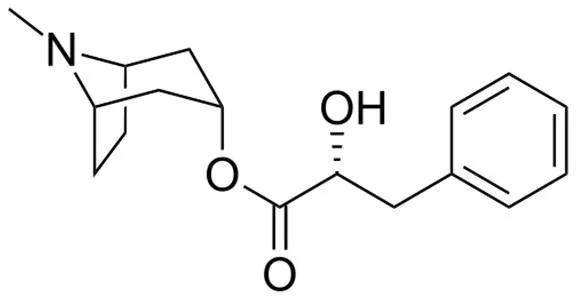| Structure Identification: |
| Phytochemistry. 2012 Feb;74:105-14. | | Norlittorine and norhyoscyamine identified as products of littorine and hyoscyamine metabolism by (13)C-labeling in Datura innoxia hairy roots.[Pubmed: 22083085] | The presence of two compounds, norLittorine and norhyoscyamine, has been reported in leaves and roots of Datura innoxia; however their metabolic origin in the tropane alkaloid pathway has remained unknown. Precise knowledge of this pathway is a necessary pre-requisite to optimize the production of hyoscyamine and scopolamine in D. innoxia hairy root cultures.
METHODS AND RESULTS:
The exact structure of norLittorine and norhyoscyamine was confirmed by LC-MS/MS and NMR analyses. Isotopic labeling experiments, using [1-(13)C]-phenylalanine, [1'-(13)C]-Littorine and [1'-(13)C]-hyoscyamine, combined with elicitor treatments, using methyl jasmonate, coronalon and 1-aminocyclopropane-1-carboxylic acid, were used to investigate the metabolic origin of the N-demethylated tropane alkaloids.
CONCLUSIONS:
The results suggest that norLittorine and norhyoscyamine are induced under stress conditions by conversion of Littorine and hyoscyamine. We propose the N-demethylation of tropane alkaloids as a mechanism to detoxify cells in overproducing conditions. | | Chembiochem. 2009 Sep 21;10(14):2382-93. | | Mechanistic insights into the cytochrome P450-mediated oxidation and rearrangement of littorine in tropane alkaloid biosynthesis.[Pubmed: 19693762] | During the biosynthesis of certain tropane alkaloids, Littorine (1) is rearranged to hyoscyamine (3).
METHODS AND RESULTS:
Recent evidence indicates that this isomerisation is a two-step process in which the first step is an oxidation/rearrangement to give hyoscyamine aldehyde (2). This step is catalysed by CYP80F1, a cytochrome P450 enzyme, which was recently identified from the plant Hyoscyamus niger; CYP80F1 also catalyses the hydroxylation of Littorine at the 3'-position. The mechanisms of the reactions catalysed by CYP80F1 were probed with synthetic deutero and arylfluoro analogues of 1. Measurement of the primary kinetic isotope effects indicates that C3' hydrogen abstraction is the rate-limiting step for the oxidation/rearrangement of natural Littorine, and for the 3'-hydroxylation reaction of the unnatural S enantiomer of Littorine. The character of the intermediates in the oxidation/rearrangement and hydroxylation reaction was probed with the use of arylfluorinated analogues of (R)-Littorine (natural stereoisomer) and (S)-Littorine (unnatural stereoisomer) as substrates for CYP80F1. The relative conversions of ortho-, meta- and para-fluoroLittorine analogues were used to obtain information on the likely intermediacy of either a benzylic radical or benzylic carbocation intermediate.
CONCLUSIONS:
The data suggest that hydroxylation takes place via a benzylic carbocation intermediate, whereas the product profile arising from rearrangement is more consistent with a benzylic radical intermediate. |
|






 Cell. 2018 Jan 11;172(1-2):249-261.e12. doi: 10.1016/j.cell.2017.12.019.IF=36.216(2019)
Cell. 2018 Jan 11;172(1-2):249-261.e12. doi: 10.1016/j.cell.2017.12.019.IF=36.216(2019) Cell Metab. 2020 Mar 3;31(3):534-548.e5. doi: 10.1016/j.cmet.2020.01.002.IF=22.415(2019)
Cell Metab. 2020 Mar 3;31(3):534-548.e5. doi: 10.1016/j.cmet.2020.01.002.IF=22.415(2019) Mol Cell. 2017 Nov 16;68(4):673-685.e6. doi: 10.1016/j.molcel.2017.10.022.IF=14.548(2019)
Mol Cell. 2017 Nov 16;68(4):673-685.e6. doi: 10.1016/j.molcel.2017.10.022.IF=14.548(2019)